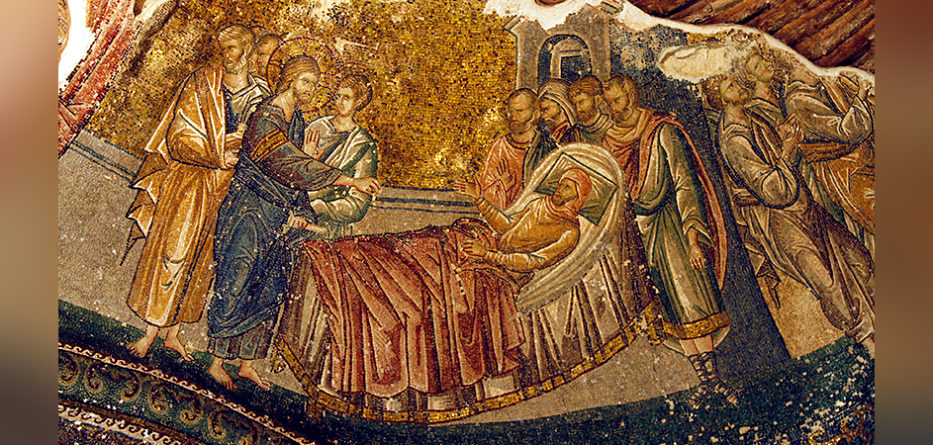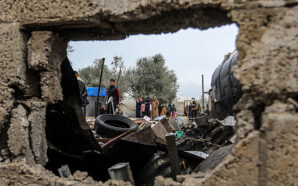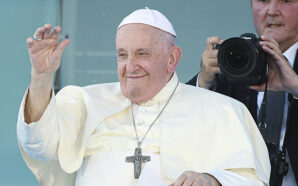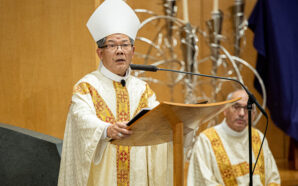Second Sunday of Advent
Readings: Baruch 5:1–9; Psalm 125 (126); Philippians 1:4–6, 8–11; Luke 3:1–6
5 December 2021
“The word of God came to John son of Zechariah, in the wilderness.” – Luke 3:2
St John the Baptist is an enigmatic figure. He mystified many around the time of Christ. He was not what anyone expected, and yet his message had the ring of authenticity about it. His origins, although extraordinary at the time of his birth, still leave a great deal covered under the cloud of the unknown.
Every year, the Church gives us the figure of John as the one chosen by God to reveal his Son to Israel. He was not exactly the one whom the leaders of ancient Israel would have chosen as a suitable precursor for the Messiah, but then again, the Messiah was not the one they would have chosen either. So, what’s new? The other Gospels reveal to us that John wore a garment of camel skin, he ate locusts and wild honey, and he lived out in the wilderness until he appeared openly to Israel.
If we had the task of choosing someone who would announce the way for the Redeemer of the world, we may be tempted to think about the messenger in ways that would more accurately engage our culture. But, God disagrees! Instead, the character and circumstances surrounding John must necessarily form part of our understanding of his message. In other words, the message of John is his person, not just his words.
There is much to ponder in the interior life of John revealed in iconic form through the contemplative attitude of his mother, Elizabeth, who for “five months kept to herself” (Lk 1:25), as well as the forced silence upon his father, Zechariah, (cf. Lk 1:20a) who learned—the hard way—that the mysteries of God are revealed to those who do not question his ways.
May we, too, find life by following John’s example and looking to Christ. Amen.
Fr Mark De Battista
Artwork Spotlight
Christ Heals the Paralytic at Capernaum – Artist Unknown
“Christ Heals the Paralytic at Capernaum” (c. 1300s) Mosaic, Outer Narthex Saint-Sauveur-in-Chora Church (Chora Museum), Istanbul, Turkey.
The healing of the paralytic man at Capernaum does not seem to be a common theme among the works of the great Masters. The image featured here is a mosaic found in the Saint-Sauveur-in-Chora Church in Istanbul. The church has had a varied history. It is part of a monastery originally built outside the city walls of Constantinople. It kept the name Chora, meaning “country” or “land” even after the walls were extended in 413–414, then placing the church within the city. The name also carries a symbolic meaning as the mosaics of the church describe Christ as the “Lord of the Living”, and Mary as the “Container of the Uncontainable”.
In 1511, with the conquest of Istanbul by the Turks, the church was converted into a mosque. Due to the prohibition against images in Islam, all inscriptions, Christian symbols, frescoes and mosaics were covered over with a thin layer of paint and lime. In 1948, two patrons from the Byzantine Institute of America and the Dumbarton Oaks Centre for Byzantine Studies sponsored a program to clean, restore and conserve the frescoes and mosaics. In 1958, Chora was opened to the public as a museum. It is now part of the historic areas of Istanbul listed in 1985 as World Heritage by UNESCO.
The mosaics were executed in the 14th century, about the time Giotto was painting in Italy. They represent some of the most important works bequeathed to us by Byzantine artists. Although we know who commissioned the works, the artists remain unknown. This is usual in the practice of iconographers—their work was seen as solely for the glory of God. The mosaics in the Outer Narthex (Entrance Hall) contain the infancy cycle of Christ’s life and numerous scenes of Christ’s miracles, including Christ Heals the Paralytic at Capernaum.
Sadly, by mandate of Turkey’s current President Recep Tayyip Erdogan, the Chora, along with Sancta Sophia, has once more been turned into a mosque. Hopefully, the mosaics will remain available for pilgrims and tourists.
St Luke has copied almost word for word St Mark’s account of this cure. Life in Palestine was very public. Each morning the door of the house was opened, and anyone who wished might come in and out. In no time, a crowd had filled the house to capacity, all eager to hear what Jesus had to say.
Into this crowd came four men carrying on a stretcher a friend of theirs who was paralysed. You can see them in the mosaic standing behind the bed. Not to be put off when they could not get through the crowd, they went up to the flat roof and easily dug out the filling between the beams and lowered their friend down directly at Jesus’ feet.
“Your sins are forgiven.” An odd way to begin a cure? Jesus was correcting a wrong view of God. The Jews automatically connected sin and suffering. If someone was sick, they argued, then the person was obviously a sinner. Sinner or not, the sick man in the Gospel would have believed that.
So, our Lord’s first words are significant. He is saying, “My friend, God is not angry with you.” He says the same to us when, suffering from the paralysis of sin, we approach him with contrite hearts—a good theme to remember as we prepare for our Christmas confession.
But the Gospel makes another important point. The paralysed man could not get to Christ himself. It was the faith of his friends that got him there. Both St Mark and St Luke say of Jesus: “Seeing their faith.” It is an incentive to us to pray for our friends, especially those who may not have enough faith to pray for themselves.
Mgr Graham Schmitzer
Fr Mark De Battista is the administrator of St Patrick’s Catholic Parish in Port Kembla and Catholic chaplain at the University of Wollongong. Born in 1970, his family migrated to Australia from Malta in 1978. He was raised in a strong Catholic family and was ordained a priest for the Diocese of Wollongong in 1995. From 2003–2007 he served in university ministry in the USA (Illinois and Colorado). From 2010–2016 he went to Rome for studies in sacred Scripture. He has served in several parishes in the Diocese of Wollongong.
Monsignor Graham Schmitzer recently retired as the parish priest at Immaculate Conception Parish in Unanderra, NSW. He was ordained in 1969 and has served in many parishes in the Diocese of Wollongong. He was also chancellor and secretary to Bishop William Murray for 13 years. He grew up in Port Macquarie and was educated by the Sisters of St Joseph of Lochinvar. For two years he worked for the Department of Attorney General and Justice before entering St Columba’s College, Springwood, in 1962. Fr Graham loves travelling and has visited many of the major art galleries in Europe.
With thanks to the Diocese of Wollongong who have supplied the weekly Advent and Christmas 2021 reflections from their publication, Blessed – Advent & Christmas Daily Reflections 2021.








